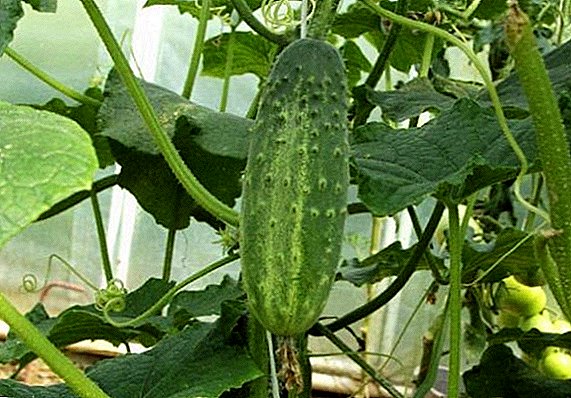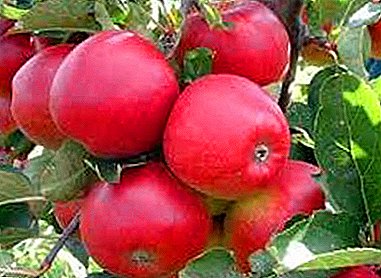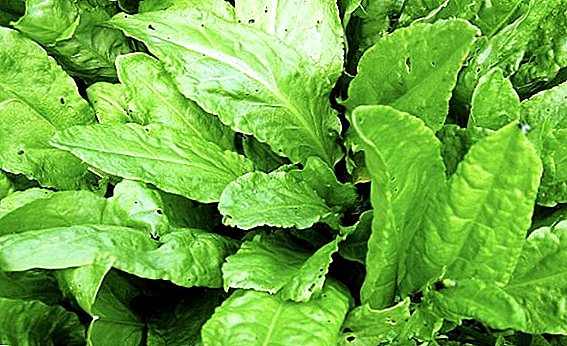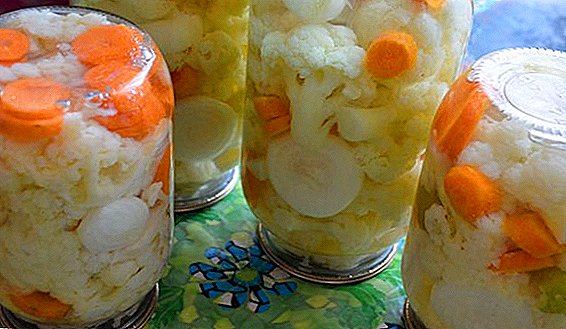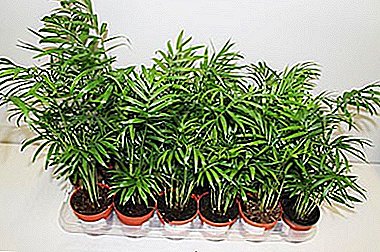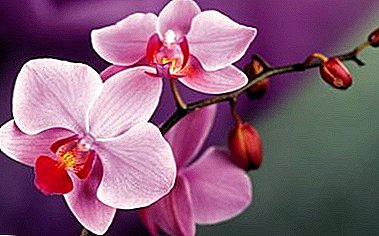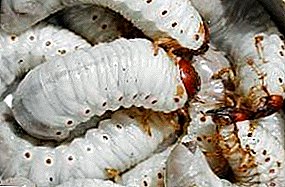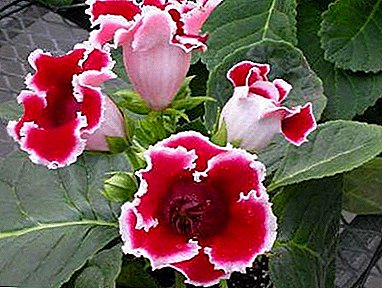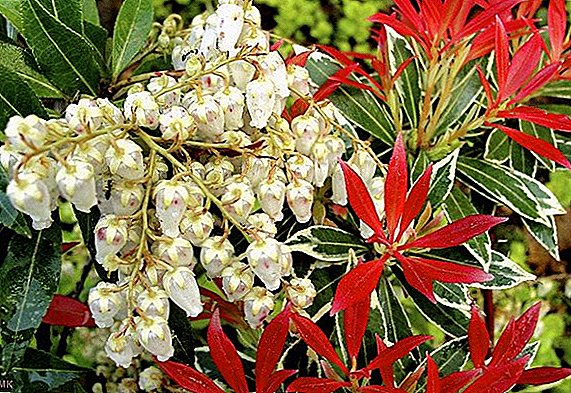
Having once looked at Japanese pieris, it becomes clear that he is able to serve as a real delight for the eyes of any gardener, in connection with his unusually attractive appearance. This plant will be an excellent choice for every gardener who wants to introduce an element of exotic on his site. This article reveals various aspects of growing Pieris Japanese, planting and caring for it.
Description and photo
Pieris is a shrubby slow-growing, evergreen plant, sometimes growing in the form of dwarf trees, which belongs to the heather family. In our area, it has a second name - pobil. Natural habitat is limited to North America, Japan and China.
Did you know? Plants of this family are in close symbiosis with fungi that are in the form of mycorrhiza. In this case, shrubs feed on substances that are obtained as a result of the vital activity of fungi and vice versa.
The height of mature representatives varies from 1 to 6 m, although it usually does not exceed 3 m. Most often, these shrubs can be found on mountain slopes, well lit by the sun, as well as in forests and shrubs. The leaves are oblong-lanceolate or elliptical, pointed to the tip, to the touch resemble the skin, the length of the leaf - up to 10 cm, and width up to 4 cm. Fresh leaves often have white, pink or reddish color. 
Buds begin to form by the end of November and remain on the branches during the entire winter period. The flowers resemble bells in their structure, up to 1.5 cm in size, are gathered into inflorescences of panicle shapes, the length of which is 5 to 12 cm. The flowers often bear a white color, but there are instances of red and pink shades.
Popular varieties
External attractiveness and good resistance to various negative environmental factors, including various parasites, diseases and frosty climate, led to the fact that breeders bred a lot of different varieties that differ significantly in external parameters:
- Pieris Japanese Flaming Silver - medium-sized variety, whose height reaches 80 cm. The leaves are dark green, shiny with a silvery edging. The flowers are white, sometimes with a red tint, bell-shaped, reminiscent of lily of the valley flowers.
- Little health - shrub rather low size with a dense crown. The height does not exceed 0.5 m. It has shoots of pink tint, which eventually change its color to green with white stripes along the edges.
- Mountain fire - dense shrub of small size. It can grow up to 150 cm in height, but this process will take quite a long period of time. The shade of foliage on the shoots varies from red to red-brown.
- Scarlet o'hara - this variety is remarkable primarily because it is characterized by much faster growth rates than for other members of this species.
- Pieris Japanese Forest Flame - An evergreen shrub, whose height reaches 1 m, is considered one of the best representatives of this species. Young shoots have a bright red color, which gradually turns into pink, and then to cream, white and, finally, to green. The presence on the bush of shoots in different forms of development makes it extremely attractive to gardeners.





Did you know? The name of this kind of plant comes from one of the nicknames of the ancient Greek muses - Pierid. By giving, they lived in one of the regions of Macedonia - Pieria, received inspiration by contemplating and consuming water from the Pierre spring.
Where to plant?
This plant requires a special approach to the issue of planting, because, like most other plants of the genus Heather, can grow not on any soil. In addition, despite their resistance to frost, there are several other environmental factors, the effects of which they do not tolerate so successfully.
Lighting and location
This shrub prefers semi-shade for its growth, it is highly desirable that the plant receive its portion of sunlight in the afternoon period. This is especially important to consider when planting variegated forms, since the lack of sunlight can lead to the fact that their leaves will be monotonous.
It is desirable that the place of future landing should be protected from the effects of cold winds and various drafts, because under their influence, Pieris will be able to drop its buds and leaves ahead of time. A good help in the proper growth and development of the shrub will be the presence of high air humidity.

Soil for the plant
In connection with the previously mentioned fact of symbiosis with some mushrooms, for this plant suitable soil exclusively with an acidic pH, in addition, it is imperative that the soil has good moisture and breathability. Role of peat or special acidified soil, which can be bought in specialized stores, will play the role of such soil in an excellent way.
Soil suitable for planting this plant can be made independently by mixing 1 part of river sand and 2 parts of sour peat. After that, almost any ingredients can be added to the mixture, for example: sawdust, needles, leaf earth. In such a soil it is highly desirable to add mineral dressing at the rate of 200 g per 1 cubic meter of soil and about 35 g of sulfur.
How to plant and how to propagate Pieris
The process of planting a plant is fairly standard, but has some peculiarities. The pit to be planted should not be deeper than 15–20 cm, since the root system of the plant is rather superficial. In addition, a young bush before planting should hold some time in the water and proceed to the immediate process only when a clod of earth and roots get wet.
The plant propagates in two main ways - with the help of seeds and grafting, both methods are equally good and are equally used by gardeners to produce healthy offspring. 
Seeds
Sow the seeds should be in shallow grooves, held with pencils in any acidic soil. Next, the seedlings are covered with glass to provide them with conditions of high humidity, put in a place protected from direct sunlight with a temperature of 22-25 ° C. Water as the soil dries. The first shoots appear, as a rule, a month after sowing.
Important! After the appearance of 3-4 leaves on young plants, they are picked into separate containers. During this period, it is recommended to carry out prophylaxis with the use of a fungicide, in order to prevent the development of the black leg.
In the spring you can begin to harden the seedlings, bringing them to fresh air for several hours. As a rule, young Pieris are transplanted to a permanent place of growth upon reaching 2-3 years of age.
Cuttings
The best period to start harvesting cuttings is the autumn period. Cuttings are cut, retreating 6-10 cm from the top of the shoot at an acute angle. Next, the cuttings must be processed with the help of coal dust and inserted into containers prepared in advance with river sand or peat, which must be constantly moistened as it dries. 
In the spring, after the last frost hits, seedlings can be transplanted to a permanent place of growth.
Peculiarities of care
This plant requires special care, recommendations for which you can find below.
Important! Remember that in connection with the surface location of the roots of pieris, it is impossible to loosen the soil next to it, instead, the soil around it is recommended to mulch.
Watering
Equally dangerous for Pieris is both a lack of moisture and its excess, which leads to rotting of the roots, ultimately leading to the death of the plant. In summer hot days the bush is watered 2-3 times a week in one bucket. If you see that the leaves of the plant begin to wilt, despite the sufficient watering, you can try to start spraying the leaves with cold settled water in the morning and evening.
Fertilizer
Freshly planted and transplanted bushes are not recommended to be fertilized for two months, but after this period it will be necessary to feed them every two weeks. Fertilizers ideal for pieris are organic liquid fertilizers, for example, diluted 1:10 bird droppings or mullein.
It is worth remembering that such fertilizers in their pure form are extremely aggressive and their use can lead to damage to the root system of the plant and its subsequent death. It is highly undesirable to apply fertilizer containing lime to fertilizing this bush.
Transfer
Pieris that grow in open ground do not require transplantation. If the plant is grown in a pot, then from time to time, namely once every 2-3 years, it is necessary to transplant it into a large pot. When transplanting it is not necessary to completely expose the root of the bush, it is necessary to transplant it with a clod of earth. 
Diseases and pests
The plant has good resistance to various diseases and pests, but sometimes under adverse conditions it can be affected by various fungal diseases and chlorosis. In order to fight the first, it is worth applying a double spraying with a solution of any fungicide, with an interval of 1 week, and the second will be saved by the introduction of an additional portion of peat or iron chelate.
Of the pests, Pierissis is most often affected by spider mites, as evidenced by the appearance of whitish sticky webs on the leaves and stalks of the plant. To overcome this attack, processing with the help of various insecticide solutions is called for.
Also, you may be interested in such ornamental shrubs for your site as: Cordilina, Cossack juniper, iglitsa, chamelacium, tabernemontana, garden yucca.
Pieris as a houseplant
The bush is very often positioned as a houseplant, although growing it at home is often associated with certain difficulties. When growing it in an apartment, the owners do not have the opportunity to choose the light mode ideally suited to the flower, which leads to the loss of its variegated properties.
Growing pierisas as indoor plants, it should be remembered that they should be watered more often than counterparts growing in the street, since the limited land and surface location of rhizomes prevent them from properly absorbing enough moisture.
The pot in which the plant is grown must be an order of magnitude larger than the diameter of the bush itself, which is associated with the structural features of the root system, which has a superficial location and a branched structure. 
So, we hope that the article has helped you come to an unequivocal conclusion as to whether you need to grow this flower in your plot or in an apartment. His unpretentious nature and ease of care should be a great addition to the already rich piggy bank of the positive properties of the plant. Good luck to you and your colors!



